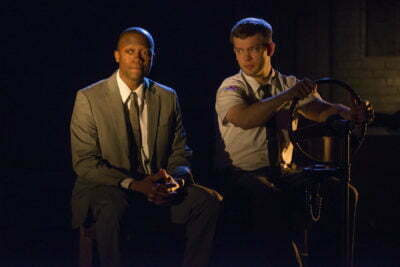In the Heat of the Night
 Adapted by Matt Pelfrey
Adapted by Matt Pelfrey
Based on the Novel by John Ball
Directed by Louis Contey
Produced by Shattered Globe Theatre, Chicago
Noir Murder Mystery Benefits from Immediacy of the Stage
Murder mysteries were one of the most popular genres of theatre once, but rarely were they as political and action-packed as Matt Pelfrey’s 2010 adaptation of In the Heat of the Night. The novel by John Ball is today best known for being the source material of the film, directed by Norman Jewison and staring Sidney Poitier and Rod Steiger, which won the Academy Award for best picture in 1967. But Pelfrey’s script and Louis Contey’s production with Shattered Globe are exciting, disturbing, and possess a stylistic flare perfect for the stage.

In the small town of Argo, Alabama, real estate mogul Charles Tatum (Tim Newell) is found murdered in the middle of the road. Police Chief Gillespie (Joseph Wiens) is instantly on edge, and starts lashing out at his subordinates. One officer, Pete (Brian Scannell), hates that Gillespie was appointed for his lack of Klan-connections, even though Gillespie is plenty bigoted, while another, Sam Wood (Drew Schad), recognizes him as incompetent. Not that Wood is any better. At the train station, he sees an unfamiliar black man, and presuming him to be the killer, immediately draws his gun and arrests him. It turns out that the man is Virgil Tibbs (Manny Buckley), a homicide investigator from Pasadena, who is visiting the South on family business. The case sounds mildly interesting to him, but after his humiliation, and Gillespie’s racist hostility, he’s not particularly eager to get involved.

Then, for no real reason, Tibbs’s boss in Pasadena orders him to contribute to the case. Tatum’s business partner, the still-influential northerner George Endicott (Glenn Fahlstrom), would also prefer to see someone who knows what he’s doing on the investigation, and Argo’s mayor (Steve Peebles) points out to Gillespie that Tibbs could be a useful tool or a fall-guy, depending on whether his investigation is successful. When it becomes clear that the Argo police care more about blaming whoever is easiest to convict instead of the actual murderer, Tibbs agrees to investigate, and he soon becomes fascinated with the twists and drama of the case. He even influences Gillespie and Wood to become a little more open-minded and concerned with truly doing justice. But the Klan is still powerful, and does not take kindly to a black homicide detective. When he learns that Tatum was a proponent of desegregation and hoped his latest project would bring about better economic opportunities for both black and white residents, Tibbs realizes that whoever killed Tatum will be coming for him next.

Louis Contey has masterfully established an eerie atmosphere. The non-verbal opening scene is one of the most strikingly erotic I’ve experienced in theatre, and the fights designed by Christina Gorman are horrifying. A major reason for the play’s diabolical feel is the scenic design by Joe Schermoly, which is made up of looming black brick walls. Combined with Michael Stanfill’s dim lighting, Argo becomes a place where enemies could be lurking in every shadow. Eva Breneman’s dialect coaching, Christopher Kriz’s old country music selections, Sarah Jo White’s costumes, and Vivian Knouse’s period-accurate props also add the appropriate amount of local color, so that despite the production’s relatively sparse visuals, it felt like a complete world in itself.

Alone against a hostile cast, Virgil Tibbs is an inherently sympathetic character. Scannell, Schad, and Peebles (in a variety of roles), provide imposing obstacles, and their character’s treatment of Tibbs is more than enough to make audiences flinch. On the other hand, Tibbs was clearly written to be the inverse of racist stereotypes instead of a character in his own right. He has a few brilliant moments, including shouting his famous “They call me Mr. Tibbs!” in response to being asked whether in his own town he’s called “boy,” but in general, he displays saintly patience despite being superior to the white characters in every way. Buckley, and, I suspect, Pelfrey do what they can with him—his mouth tightens slightly in response to every insult and he relishes in his petty acts of revenge, but Tibbs lives according to the “be twice as good” ideal which is possible only for fictional characters.
The redeeming factors in this presentation are that Tibbs investigates the Argo police themselves, eventually succeeds in penetrating the blue wall of silence, and that the ending is altered from the novel and movie to acknowledge the need to confront larger social forces head-on. That the more modern approach to institutional racism is present, but imperfectly jammed into an old-fashioned story, is the only thing about the production that could give someone pause. In every other regard, it’s an absorbing, evocative transfer of the film noir aesthetic to the stage.
Recommended
Jacob Davis
Reviewed April 24, 2016
This show has been Jeff recommended.
For more information, see In the Heat of the Night’s page on Theatre in Chicago.
Playing at Theater Wit, 1229 W Belmont Ave, Chicago.

